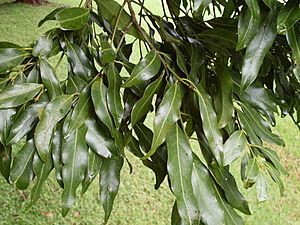Cinnamomum oliveri facts for kids
Quick facts for kids Cinnamomum oliveri |
|
|---|---|
 |
|
| Leaves of Cinnamomum oliveri Foxground, Australia | |
| Scientific classification | |
| Genus: |
Cinnamomum
|
| Species: |
oliveri
|
Cinnamomum oliveri is a special tree that grows in the rainforests along the eastern coast of Australia. You can find it from the Illawarra area in New South Wales all the way up to the very top of Australia, called Cape York Peninsula. The most southern places where this tree grows naturally are on cliffs near the town of Gerroa and on the sand behind Seven Mile Beach.
This tree was named after Daniel Oliver, a botanist from Kew Gardens. Cinnamomum oliveri has a few common names. People sometimes call it the camphorwood, Oliver's sassafras, black sassafras, or cinnamonwood. It can grow to be a medium to large tree, reaching about 30 metres (almost 100 feet) tall and 75 centimetres (about 30 inches) wide.
Contents
Where It Lives
This tree is often found in warm rainforests, especially in cool mountain areas with certain types of soil. You can also see it in subtropical rainforests, which are warmer and wetter.
What It Looks Like
Trunk, Bark, and Leaves
The trunk of the Cinnamomum oliveri tree is usually round, but sometimes it can have a wider base. Its bark is grey or brown and feels a bit like cork. You might also see vertical lines of bumpy, cork-like spots on the trunk.
The leaves grow in pairs, one across from the other. They are simple, meaning each leaf is a single blade, and have slightly wavy edges. They are smooth and shaped like a spear, with a pointed tip and a base that slowly gets narrower. Each leaf is about 8 to 15 centimetres long and 2 to 4 centimetres wide. The top side of the leaf is shiny green, while the underside is a bluish-grey color, which is called glaucous. The leaf stalk, which connects the leaf to the branch, is about 6 to 12 millimetres long. You can clearly see the veins on both sides of the leaf, and the main vein (midrib) sticks out on both surfaces.
Flowers, Fruit, and Seeds
The flowers of Cinnamomum oliveri appear from October to November. They are creamy white and smell nice. These flowers grow in clusters at the ends of the branches or where the leaves meet the branch.
The fruit is an oval-shaped, shiny, blue-black or black drupe. A drupe is a type of fruit with a hard pit inside, like a peach. The fruit also smells good. It's about 12 millimetres long. Sometimes, you might see small bumps on the fruit, which are called galls. The fruit ripens from February to April. These trees produce a lot of fruit, but it usually happens only about every seven years.
Rainforest birds love to eat this fruit. Some of these birds include the white-headed pigeon, the pied currawong, and the green catbird. To help the seeds grow, it's best to remove the soft, fleshy part of the fruit. The seeds don't last long if they get dry, so they need to be planted fairly quickly.
What It's Used For
The bark of Cinnamomum oliveri contains a substance called tannin, which is used in some industries. It also has an essential oil. This oil is rich in compounds like camphor, safrole, and methyleugenol or cinnamic aldehyde and eugenol. The exact mix of these compounds can be different depending on the specific type of tree. This oil can be used for medicinal purposes.
The wood of the tree smells pleasant and is used for things inside buildings, like wall linings and making furniture. It is quite strong, weighing about 560 to 660 kilograms per cubic metre.
Gallery
-
Cinnamomum oliveri - young tree, Foxground
-
Cinnamomum oliveri - bark, Foxground
-
Cinnamomum oliveri at Seven Mile Beach, New South Wales
(other publication details, included in citation)
See also
 In Spanish: Cinnamomum oliveri para niños
In Spanish: Cinnamomum oliveri para niños




